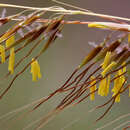Comprehensive Description
provided by North American Flora
Sorghastrum secundum (Ell.) Nash, in Small, Fl. SE
U. S. 67. 1903.
Andropogon secundus EH. Bot. S. C. & Ga. 1 : 580. 1821. Sorgum secundum, Chapm. Fl. S. U. S. 583. 1860. Chrysopogon secundus Benth.; Vasey, Grasses U. S. 20. 1883. Andropogon unilateralis Hack, in DC. Monog. Phan. 6 : 533. 1889.
Stems 8-14 dm. tall; leaf-sheaths smooth and glabrous; blades 6 dm. long or less, up to 7 mm. wide, smooth beneath, rough above, often involute; panicle 2-4 dm. long, 1-sided, its branches erect or nearly so, rarely exceeding 4 cm. in length, usually shorter than the internodes of the axis, the ultimate divisions or peduncles strongly recurved or coiled below the spikelets; spikelets 6-8 mm. long, lanceolate, golden-brown at mattu-ity, hirsute, the awn of the foiurth scale 2.5-3 cm. long, the geniculate column several times longer than the spikelet.
Typk locality : High ridges between the Flint and Chattahoochee rivers, Georgia. Distribution : South Carolina to Florida.
- bibliographic citation
- George Valentine Nash. 1912. (POALES); POACEAE (pars). North American flora. vol 17(2). New York Botanical Garden, New York, NY
Physical Description
provided by USDA PLANTS text
Annuals, Perennials, Terrestrial, not aquatic, Stems nodes swollen or brittle, Stems erect or ascending, Stems caespitose, tufted, or clustered, Stems terete, round in cross section, or polygonal, Stems branching above base or distally at nodes, Stem nodes bearded or hairy, Stem internodes hollow, Stems with inflorescence less than 1 m tall, Stems with inflorescence 1-2 m tall, Stems, culms, or scapes exceeding basal leaves, Leaves mostly cauline, Leaves conspicuously 2-ranked, distichous, Leaves sheathing at base, Leaf sheath mostly open, or loose, Leaf sheath smooth, glab rous, Leaf sheath hairy, hispid or prickly, Leaf sheath and blade differentiated, Leaf blades linear, Leaf blades 2-10 mm wide, Leaf blades mostly flat, Leaf blade margins folded, involute, or conduplicate, Leaf blades mostly glabrous, Leaf blades scabrous, roughened, or wrinkled, Ligule present, Ligule an unfringed eciliate membrane, Inflorescence terminal, Inflorescence a contracted panicle, narrowly paniculate, branches appressed or ascending, Inflorescence a dense slender spike-like panicle or raceme, branches contracted, Inflorescence solitary, with 1 spike, fascicle, glomerule, head, or cluster per stem or culm, Inflorescence a panicle with narrowly racemose or spicate branches, Inflorescence branches more than 10 to numerous, Inflorescence branches 1-sided, Flowers bisexual, Spikelets pedicellate, Spikelets sessile or subsessile, Spikelets dorsally compressed or terete, Spikelet less than 3 mm wide, Spikelets with 1 fertile floret, Spikelets paired at rachis nodes, Spikelets 3 per node, Spikelets all alike and fertille, Spikelets in paired units, 1 sessile, 1 pedicellate, Pedicellate spikelet rudimentary or absent, usually sterile, Spikelets bisexual, Spikelets disarticulating below the glumes, Spikelets falling with parts of disarticulating rachis or pedicel, Glumes present, empty bracts, Glumes 2 clearly present, Glumes equal or subequal, Glumes equal to or longer than adjacent lemma, Glume equal to or longer than spikelet, Glume surface hairy, villous or pilose, Glumes 8-15 nerved, Lemmas thin, chartaceous, hyaline, cartilaginous, or membranous, Lemma 1 nerved, Lemma glabrous, Lemma apex dentate, 2-fid, Lemma distinctly awned, more than 2-3 mm, Lemma with 1 awn, Lemma awn 2-4 cm long or longer, Lemma awn from sinus of bifid apex, Lemma awn once geniculate, bent once, Lemma awn twice geniculate, bent twice, Lemma margins thin, lying flat, Lemma straight, Palea membranous, hyaline, Palea shorter than lemma, Stamens 3, Styles 2-fid, de eply 2-branched, Stigmas 2, Fruit - caryopsis.

